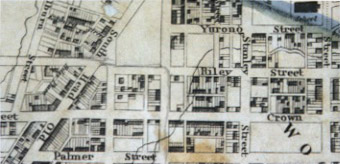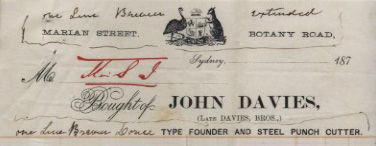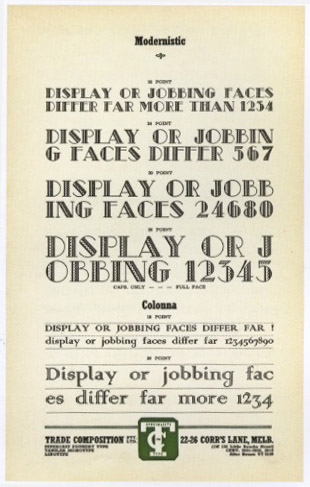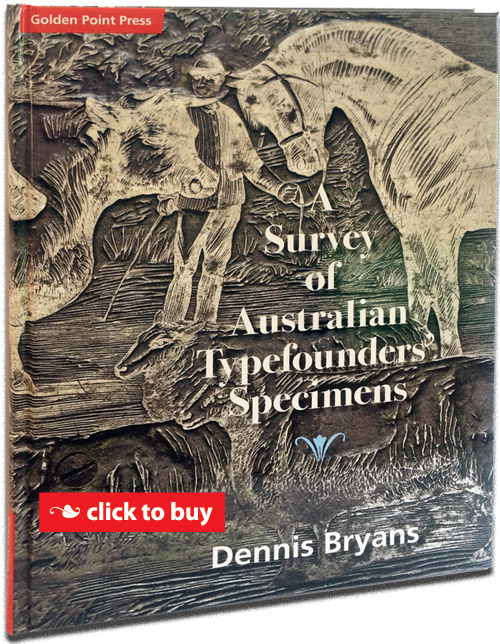The result of 25 years research and the author's own meticulous design and typesetting, this hard-cover, 86-page book depicts the earliest known typographic designs and livestock brands cast by Australian typefounders for colonial governments in Queensland, New South Wales, and South Australia.
Previously unrecognised specimens of colonial typographic designs, first mentioned in the New South Wales press more than 150 years ago, show skills and workmanship exhibited by Australia's pioneer type founders. These specimens present a vital source of information for graphic designers and print historians, and offer insights into our printing past for the general reader.
Biographical information and additional specimens from various public collections is included to give context to the newly discovered items.
Types for bookwork and job printing were also engraved and cast by the local type founders, often mimicking the designs of English and American founderies.
The illustrations of surviving type specimens are of bibliographical interest, supplemented with portraits of typefounders and photographs of foundries.
How I came to write A survey of Australian Typefounders' Specimens
As a teacher of graphic design specializing in typography in the 1990s I began to question the emphasis on teaching British, European and American typographic history in Australia without any acknowledgement of typographic design developments in this country. On a holiday in Broken Hill I obtained some fonts of metal type and a few examples of wood type and soon afterwards discovered that type had been cast in Sydney as early as 1841.
 I visited Sydney and walked the streets where type foundries had at one time existed and began to research type exports from New South Wales to other Australasian colonies. This resulted in the publication of two articles, the first in the Journal of Design History entitled ‘The Beginnings of Type Founding in Sydney : Alexander Thompson’s Type, His Foundry, and His Exports to Inter-Colonial Printers,’ and a second article in the BSANZ Bulletin (1999) called “Nineteenth-Century Australian Type Foundries,” which drew attention to other firms of a later date. There the matter rested. Nevertheless my interest in the subject did not diminish, and in February of this year I revisited Sydney with a view to fleshing out missing details in the lives of the type founders, a goal that I fully achieved to my expectations. On my return I resolved to follow up another old lead that I had made in South Australia. As it turned out this was the pot of gold at the end of the rainbow because printed type specimens mentioned in the Sydney Press in 1857-58, but only known from news reports, had been preserved in the South Australian State Records Office and it is these that make up a significant portion of the illustrations in the book.
I visited Sydney and walked the streets where type foundries had at one time existed and began to research type exports from New South Wales to other Australasian colonies. This resulted in the publication of two articles, the first in the Journal of Design History entitled ‘The Beginnings of Type Founding in Sydney : Alexander Thompson’s Type, His Foundry, and His Exports to Inter-Colonial Printers,’ and a second article in the BSANZ Bulletin (1999) called “Nineteenth-Century Australian Type Foundries,” which drew attention to other firms of a later date. There the matter rested. Nevertheless my interest in the subject did not diminish, and in February of this year I revisited Sydney with a view to fleshing out missing details in the lives of the type founders, a goal that I fully achieved to my expectations. On my return I resolved to follow up another old lead that I had made in South Australia. As it turned out this was the pot of gold at the end of the rainbow because printed type specimens mentioned in the Sydney Press in 1857-58, but only known from news reports, had been preserved in the South Australian State Records Office and it is these that make up a significant portion of the illustrations in the book.
 It was by accident that I discovered that Davies Brothers, of Redfern, Sydney, were contracted by the Queensland Government to supply designs for horse, cattle and sheep brands for the colony. What was more unexpected was that records of these designs were sent to South Australia when that colony introduced legislation to meet the same purpose. Background information and additional specimens from other collections is included to give context to the newly discovered items.
It was by accident that I discovered that Davies Brothers, of Redfern, Sydney, were contracted by the Queensland Government to supply designs for horse, cattle and sheep brands for the colony. What was more unexpected was that records of these designs were sent to South Australia when that colony introduced legislation to meet the same purpose. Background information and additional specimens from other collections is included to give context to the newly discovered items.
 My interest in printing history extends to Australian book publishing wherever and whenever books have been printed in Australia. To this end I have done extensive research into Melbourne printing firms, most of all the ”Specialty Press’ the life of which spanned 70 years and was significantly both printer and publisher. It therefore has an important place in the history of Australian literature, theatre, and greeting card manufacture. This has led me to write several articles and papers on aspects of the firm’s output and book publishing and the printing industry more generally. My PhD thesis in 2000 was called “A Seed of Consequence – Indirect Image Transfer and Chemical Printing.” Published articles include periodicals; “Magazines a Specialty : The Specialty Press and the Commercial Travellers Association” BSANZ Bulletin (2004); book publishing “The Australian Book Crisis 1939-1945” (2008) which examines the shortage of printing materials and manpower during the war The Journal of St Bride Library; “The Trials of Robert Close” Script and Print, on literary censorship (2011); “A Tolerable Interpreter; Robert Bell and the Chinese on the Ballarat Goldfields”, La Trobe Journal, December 2013, dealing with an English and Chinese newspaper that Bell edited, printed and distributed.
My interest in printing history extends to Australian book publishing wherever and whenever books have been printed in Australia. To this end I have done extensive research into Melbourne printing firms, most of all the ”Specialty Press’ the life of which spanned 70 years and was significantly both printer and publisher. It therefore has an important place in the history of Australian literature, theatre, and greeting card manufacture. This has led me to write several articles and papers on aspects of the firm’s output and book publishing and the printing industry more generally. My PhD thesis in 2000 was called “A Seed of Consequence – Indirect Image Transfer and Chemical Printing.” Published articles include periodicals; “Magazines a Specialty : The Specialty Press and the Commercial Travellers Association” BSANZ Bulletin (2004); book publishing “The Australian Book Crisis 1939-1945” (2008) which examines the shortage of printing materials and manpower during the war The Journal of St Bride Library; “The Trials of Robert Close” Script and Print, on literary censorship (2011); “A Tolerable Interpreter; Robert Bell and the Chinese on the Ballarat Goldfields”, La Trobe Journal, December 2013, dealing with an English and Chinese newspaper that Bell edited, printed and distributed.
In 1996 I established Golden Point Press as printer publisher. On the printing side type and presses were purchased for printing ephemeral items such as greeting cards and learning more about ink, paper, type and the printing process from first-hand experience. A collection of disused foundry type yielded a good many examples of 19th century specimens, which improved my understanding of typography and its development.
Dennis Bryans
Shown here are just a few of the many original documents and book covers reproduced in this book.


